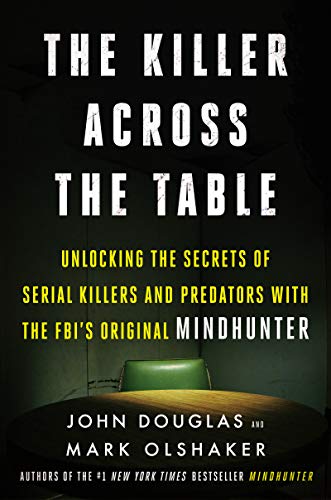The Killer Across the Table: Unlocking the Secrets of Serial Killers and Predators with the FBI's Original Mindhunter

“John Douglas walks into rooms most of us would shun in our worst nightmares and comes back with remarkable insight into what type of person perpetrates such horrible acts.”
To say that John Douglas is well known among practitioners of criminal investigation, not to mention authors and readers of true crime and crime fiction, is an understatement. One of the early members of the FBI’s Behavioral Science Unit and the man who has become known as the Original Mindhunter, Douglas has become very influential in the world of criminal investigation through publications such as the Crime Classification Manual (1992; 2006), Journey into Darkness (1997), Law and Disorder (2013), and of course Mindhunter (1995).
What to expect, then, from his latest book with long-time collaborator Mark Olshaker? The Killer Across the Table takes us once more into the actions and motives of serial killers as Douglas examines four subjects in particular that he hasn’t written about before in such detail: Joseph McGowan, Joseph Kondro, Donald Harvey, and Todd Kohlhepp.
Douglas explains at the onset that this is a book about the way violent predators think. In each of these four cases, he was called in either to interview the killer or to consult in the background, and the resulting material has been organized carefully to reflect his initial study of the case files, his interview of the subject, and his analysis and conclusions, such as they are.
As he admits, in trying to explain why these individuals kill, “the best we can offer is theories.” But he firmly reminds readers that his approach, and that of his former FBI colleagues, has always been consistent with “the criminal analysis side of behavior science” rather than the approach a clinical psychiatrist or psychologist would take.
Those familiar with his work will recognize certain generalizations that Douglas repeats here in order to orient the reader. “Past behavior is the best predictor of future behavior,” he reminds us, explaining the detailed biographical study he undertakes with each subject. Then there’s his well-known assertion that “to understand the artist, you must look at the artwork.”
As well, in each of the four instances, Douglas offers brief digressions to expand on his point by referring to cases in his storied past. When setting up his interview with McGowan, for example, he compares his approach to one that he followed with Wayne B. Williams, the Atlanta Child Murderer. As well, during his interview with Joseph Kondro, he contrasts Kondro’s answers regarding motive and triggering events with what Dennis Rader, the notorious B.T.K. killer, had told him about his own experiences.
However, lest one jump to the conclusion that Douglas is now publishing a predictable rehash of previous material merely to cash in on the popularity of the current Netflix series Mindhunter, it’s important to note that each of these four cases brought something unusual and uncommon to Douglas’s attention.
What made Joseph Kondro different, for example, was that he targeted known victims personally close to him rather than unknown children in an area far from his own home. Donald Harvey, referred to as the Angel of Death because he was a particularly egregious practitioner of medical murder, was different than most serial killers because his murders were consistently presumed to be death by natural causes.
Todd Kohlhepp was an outlier because he was a successful and wealthy real estate broker who hauled bodies around in his Acura Legend. He also wrote online reviews of products purchased on Amazon, such as folding shovels, knives, and chainsaws, and referred in each review to their relative utility in his actual or contemplated murders.
Interestingly, the Kondro and Kohlhepp interviews were arranged as part of a proposed MSNBC series that never made it past the pilot. The network was dissatisfied with the outcome and the series was not picked up.
Although the killers talked at great length and disturbing detail about their kills, it was actually Douglas with whom the network was unhappy. He failed to get into the killers’ faces, to express his moral outrage, to channel the horror and disgust viewers would be sure to feel as they watched the interviews unfold.
As Douglas remarks, “my role is to get these guys to talk, to find out what is, and what was, going on inside their minds. Confrontation and moral indignation do not achieve that.”
While he does offer a few personal opinions and emotional reactions in this book, most likely to remind readers that he’s a human being and not a machine, Douglas remains true to the modus operandi that has made him such an influential figure in criminal profiling: focus, attention to detail, and subtle manipulation of the predator across the interview table from him.
While it’s disturbing in its detail, The Killer Across the Table is a must read for everyone wanting to understand the minds of depraved serial killers. Once again John Douglas walks into rooms most of us would shun in our worst nightmares and comes back with remarkable insight into what type of person perpetrates such horrible acts.